Amy Fine Collins
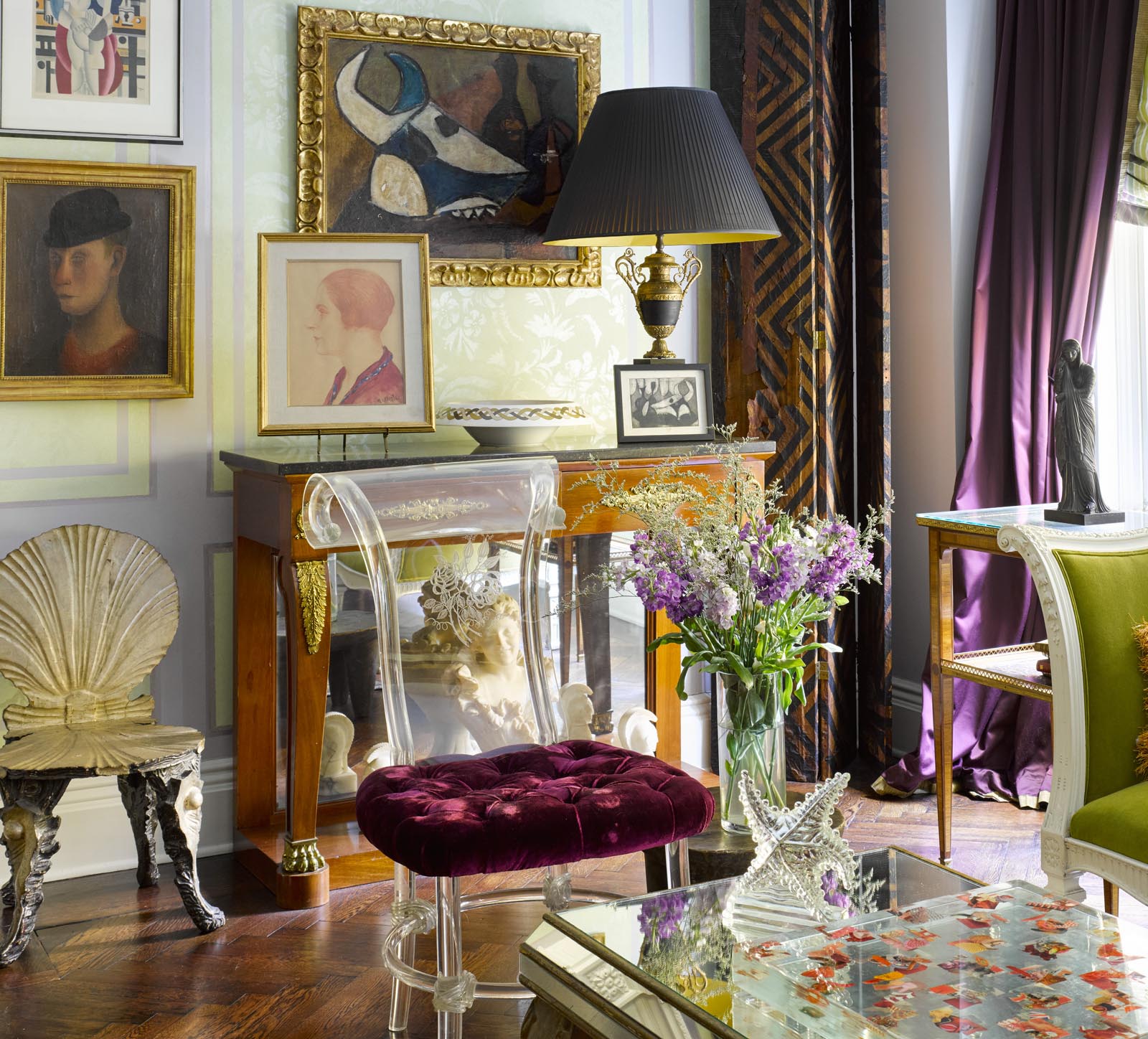
In the sitting room is a 1930s Lucite chair by Ladislas Medgyes, one of the first ever made, etched with a rose, from the estate of Helena Rubinstein; behind it is a 1929 red chalk and watercolor portrait of Helena Rubinstein, by M.L. Closset. Above is an abstract still life by Amy’s mother, Elsa Honig Fine. Tucked in the corner is one of a pair of Tapa barkcloth-covered screens built by the photographer Horst. On the glass coffee table is a multi-layered glass collage chessboard by sculptor Dustin Yellin.
Amy Fine Collins’s apartment is such fun, so imperiously, light-heartedly purple and with such a lapidary jewel-like quality that it’s hard to find prose to match; underneath its style and individuality are parody, intelligence, fantasy and humor. Much like its owner. It’s also wittily referential and by way of being a homage to the cosmetics entrepreneur Helena Rubinstein. You can’t quite read the apartment – though you could still get a frisson of delight from looking at it – unless you know something of the inspirational drive of the two amazing women behind it, Helena then, Amy now.
Amy’s garnering of furniture and paintings from various sales of Helena Rubinstein’s possessions shows the cosmetics queen to be have been a discerning, acute and vain collector, with a great eye for both contemporary art and self-promotion. “For a start she was so avant-garde,” Amy says. Helena Rubinstein had distinct ideas about how her apartments should look and that look became a sort of benchmark for the baroque culture-of-excess decoration of the times: satin padded walls, silvered grotto furniture, blackamoors – of course – and elaborate French salon furniture of the mid- nineteenth century. She had a large collection of pictures by Picasso, Matisse and neo-romantic and surrealist painters and many – many! – portraits of herself commissioned from, among others, Salvador Dalí, Pavel Tchelitchew and Paul César Helleu. There are at least eight big portraits of her throughout Amy’s apartment.
Amy Fine Collins’s official title is Special Correspondent to Vanity Fair, which is a catch-all title for being at the center of things in a certain world. She has a long reach. She is an art historian and a writer, a muse for many fashion designers (most particularly for Geoffrey Beene) and a focus for style mavens; and her pieces for Vanity Fair encompass a good deal more than fashion and style – her article on the sex trafficking of young Americans, “The Girls Next Door,” was not only the most-read article in the history of vanityfair.com at the time, it helped change the law of the United States. She speaks very fast, makes one laugh, and doesn’t mince her words.
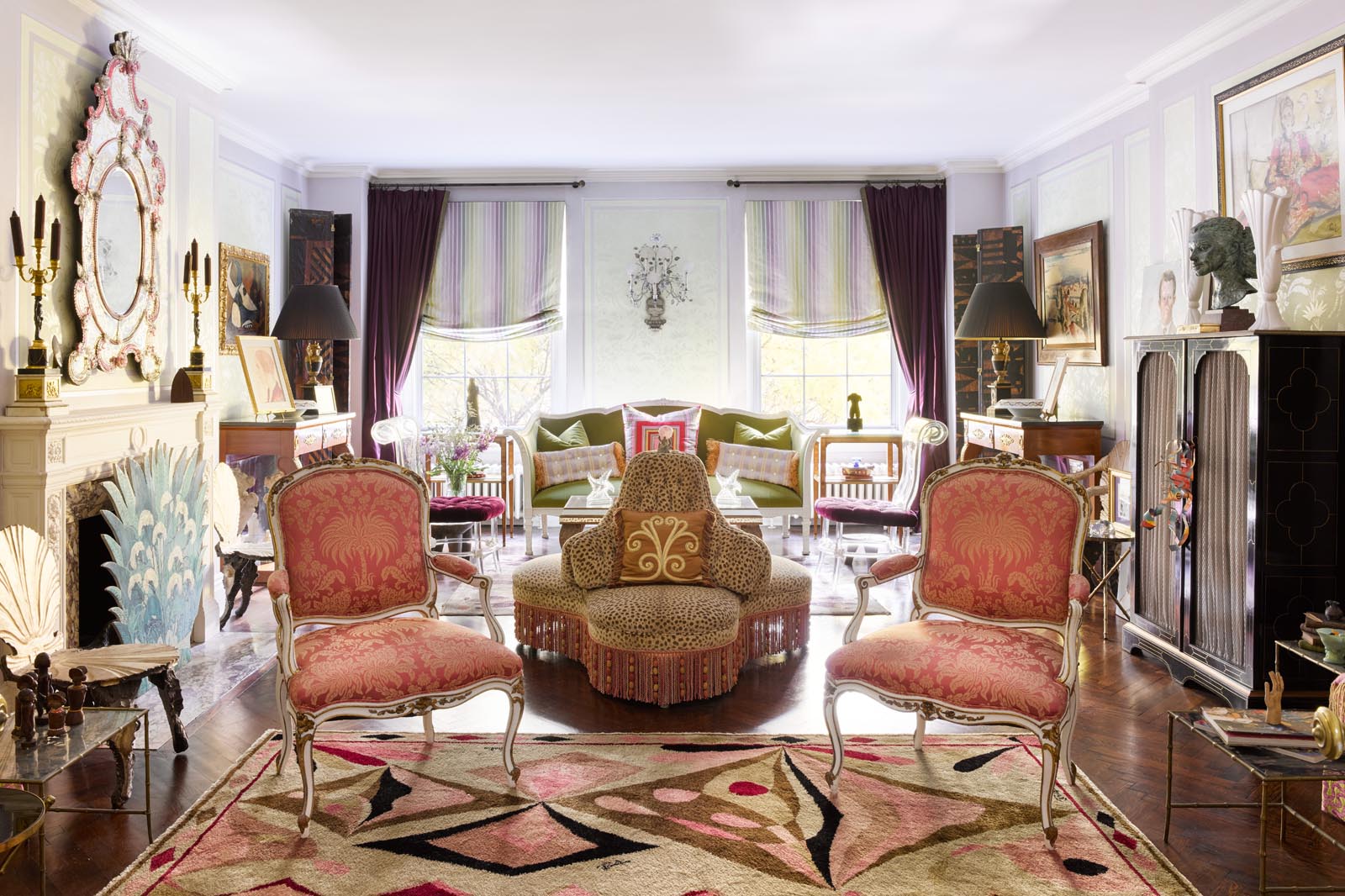
Light pours into the sitting room through south-facing windows. Between them is one of three exquisite Baguès sconces, similar to those in Cole Porter’s Waldorf Astoria apartment. The 1930s Venetian mirror above the fireplace came from the estate of Helena Rubinstein and the 1950s fire screen below is by Federico Pallavicini, who designed packaging and decorated salons and houses for her. The c.1970 rug was designed by Emilio Pucci.
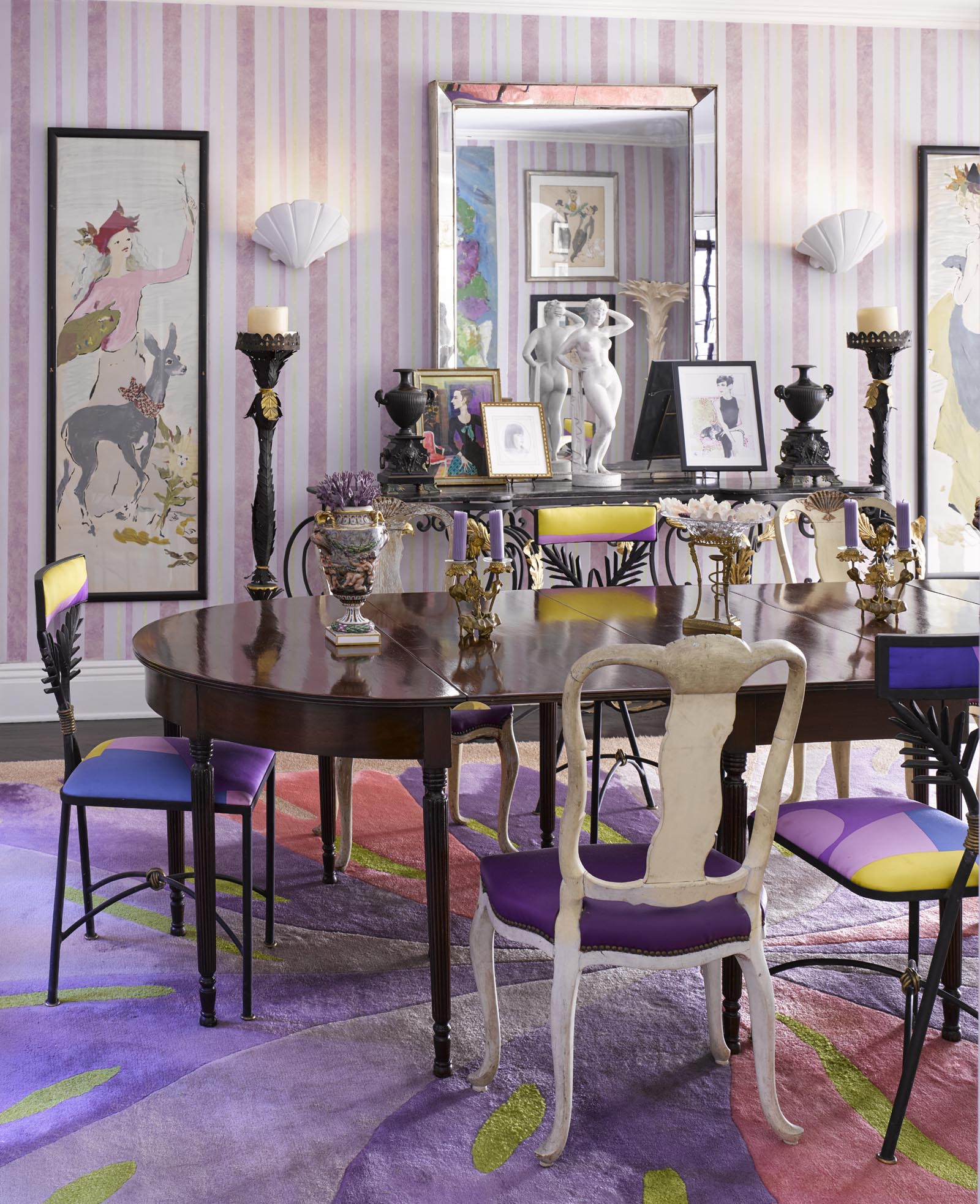
In the dining room, light-hearted panels by Marcel Vertès hang on walls painted by Robert Hoven. The pickled and white-painted Italian chairs are by Syrie Maugham, next to Nicaraguan designer Mario Villa’s metal palm-frond chairs covered in Gene Meyer scarves. A plaster sculpture of Mae West by Gladys Lewis stands between bronze urns by Tiffany & Co., of c.1890.
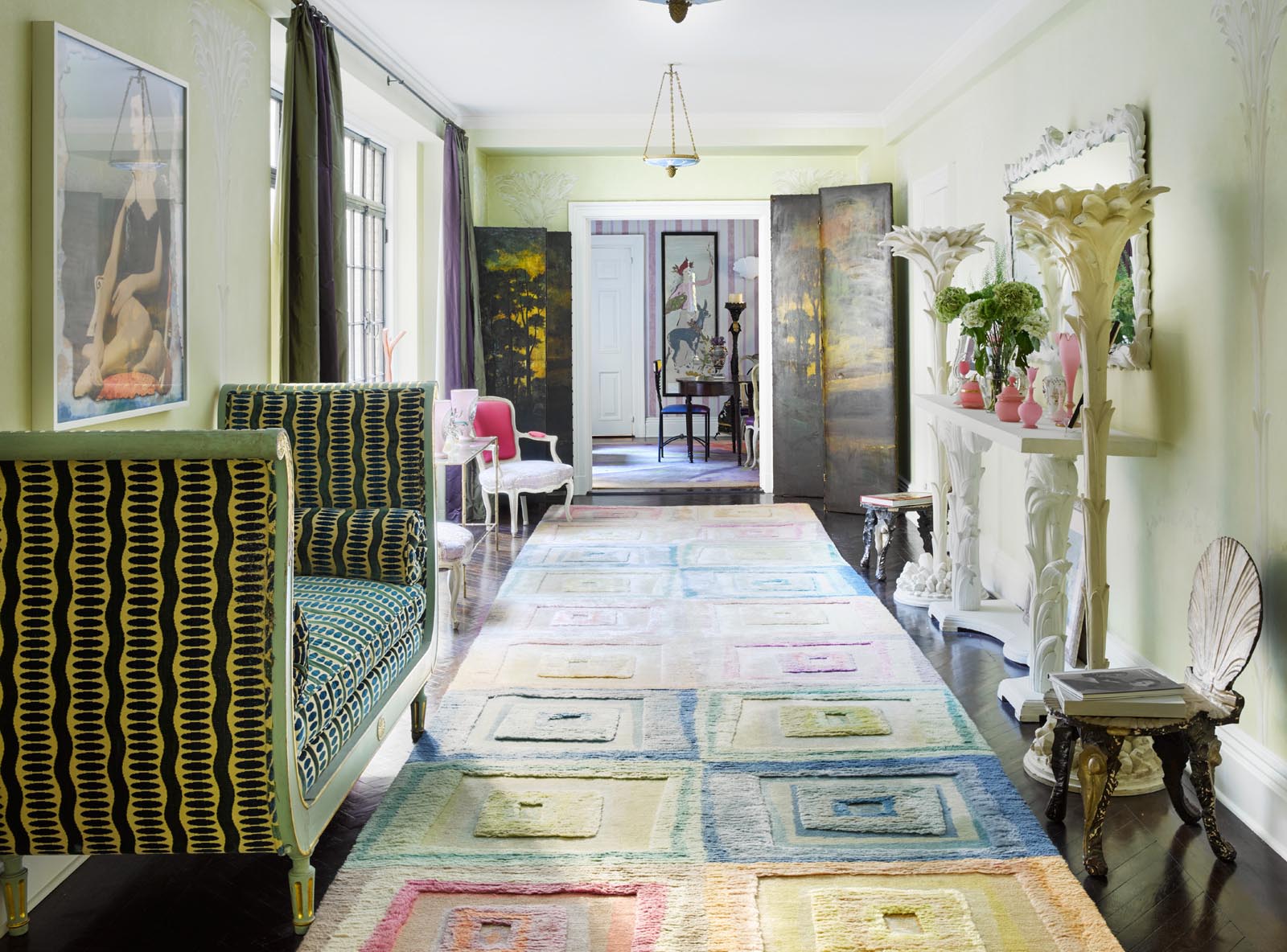
The hallway carpet, custom-made by Gene Meyer, leads the eye to a pair of Victorian folding screens framing the dining room doorway. Two palm torchères flank a console and looking glass, all designed by Serge Roche; the pink opaline glass vases are from the estate of Helena Rubinstein. The set of silver-gilt grotto chairs – two here, others in the living room – is probably Venetian.
Geoffrey Beene was a huge influence in her life and style (in a witty triple entendre he called her Amuse). She met him after he read her article “The Wearable Rightness of Beene,” in which, as an art historian, she analyzed the aesthetic decisions and finished work of this greatest of American fashion designers, and he wrote: “How is it possible that you know me better than I know myself . . . when we haven’t even met?” He influenced her immaculate look – “The look I maintain today still bears Beene’s defining imprint.”
Before I met her, though she was a Presence, an arbiter of style in the world of Hautezine, I thought that one of the key phrases defining Amy Fine Collins was the title of a book she co-authored, Simple Isn’t Easy, subtitled How to Find Your Personal Style and Look Fantastic Every Day! (Which she does.) And thus I imagined that her apartment just off Park Avenue would have the simplicity of, say, a haiku.
Fâcheuse illusion. The place where this long-legged, raven-haired person lives, with her husband, Professor Bradley Collins, and beautiful daughter, Flora, and VIP cat, Leo, has a distinct aesthetic. This is neo-baroque par excellence. Curious, hybrid, highly strung, fancy and fanciable, grand and enchanting, it brims with éclat – as well as with key pieces from Helena Rubinstein’s legacy tracked down from auctions over the years. The screen in front of the original fireplace in her sitting room was painted by Federico Pallavicini, who in the late fifties was an artistic consultant and interior designer for Madame, as she liked to be called. (Earlier he had helped create the innovative magazine Flair for Fleur Cowles.) Above the mantelpiece is a mirror left to Helena Rubinstein’s nephew Oscar, sold at auction after his death.
The Collins apartment is not pastiche, but it is – as Helena Rubinstein’s was – a reaction to mainstream interior design. It manifests itself in Amy’s exuberant love of shapes and detail and the decorative possibilities of ornament, exemplified in her own personal way of dressing: a ferocity of elegance.
Many signifiers from the fifties are at home here – paintings by Marcel Vertès, the French-Hungarian costume designer and illustrator who won two Academy Awards for his work on the 1952 film Moulin Rouge, and whose fifties murals in the Café Carlyle are much loved by New Yorkers; drawings by the cherished artist, illustrator and designer Christian Bérard – Bébé to his friends – and pieces by contemporary artists, usually friends.
Then there’s the Léger painting found by her husband in the south of France when he was thirteen (precocious or what?). Every day she writes – and she writes a lot – at a desk once owned by Hugh Hefner. (The dealer wasn’t sure whether he should tell her of its provenance or not. As if she cared.) A note from her daughter, Flora – “You are the beest Moma in the wole world” – is pinned near to a Skrebneski drawing and to sketches of Amy as a child by her formidably gifted mother, Elsa Honig Fine. “I worked on that,” Amy says, “I could get her attention if I posed for her.” Her mother is a much-awarded writer, art historian and professor, the author of a pioneering study, The Afro-American Artist: A Search for Identity, published in 1973; her father, Harold Fine, was a psychologist and psychoanalyst. “I also loved art but, although I was a good artist as a child, I stopped. I thought, I am never going to be good enough as a painter so I completely converted that aesthetic drive into clothing.” Indeed. She once said, “I will be my own canvas.”
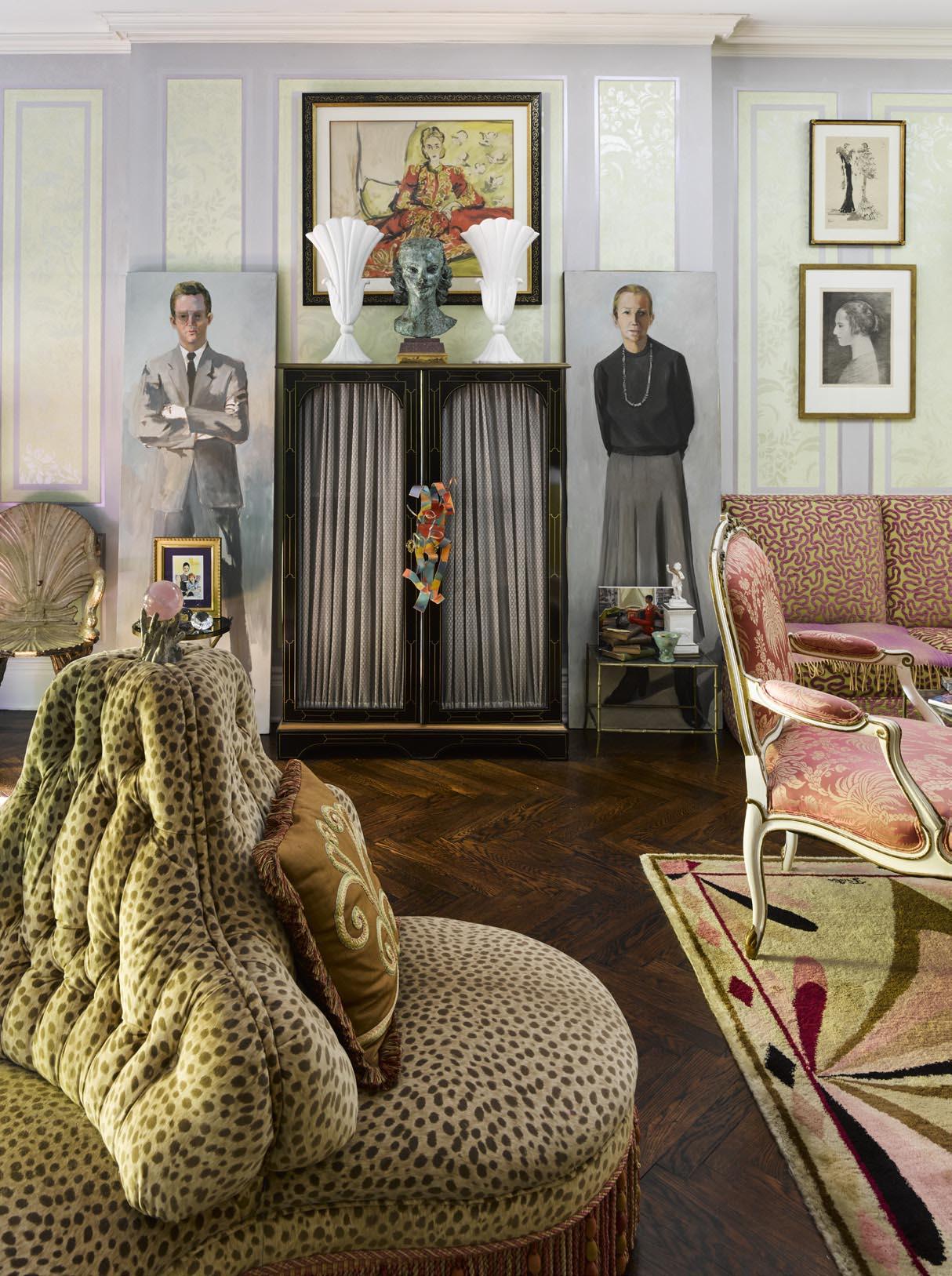
Beyond the leopard-print-covered three-lobed ottoman in the living room are portraits by Dorothy Gillespie of fashion historian Richard Martin and Amy’s mother, Elsa Honig Fine; a metal maquette, also by Gillespie, hangs on the cabinet between them. On it, a bronze bust of actress Linda Christian by Jacques Lipchitz stands in front of a gouache of Barbara Hutton by fashion illustrator Carl Erickson (Eric). To the right, a Christian Bérard fashion drawing hangs above a profile portrait of Helena Rubinstein by the Polish painter and engraver Louis Marcoussis.
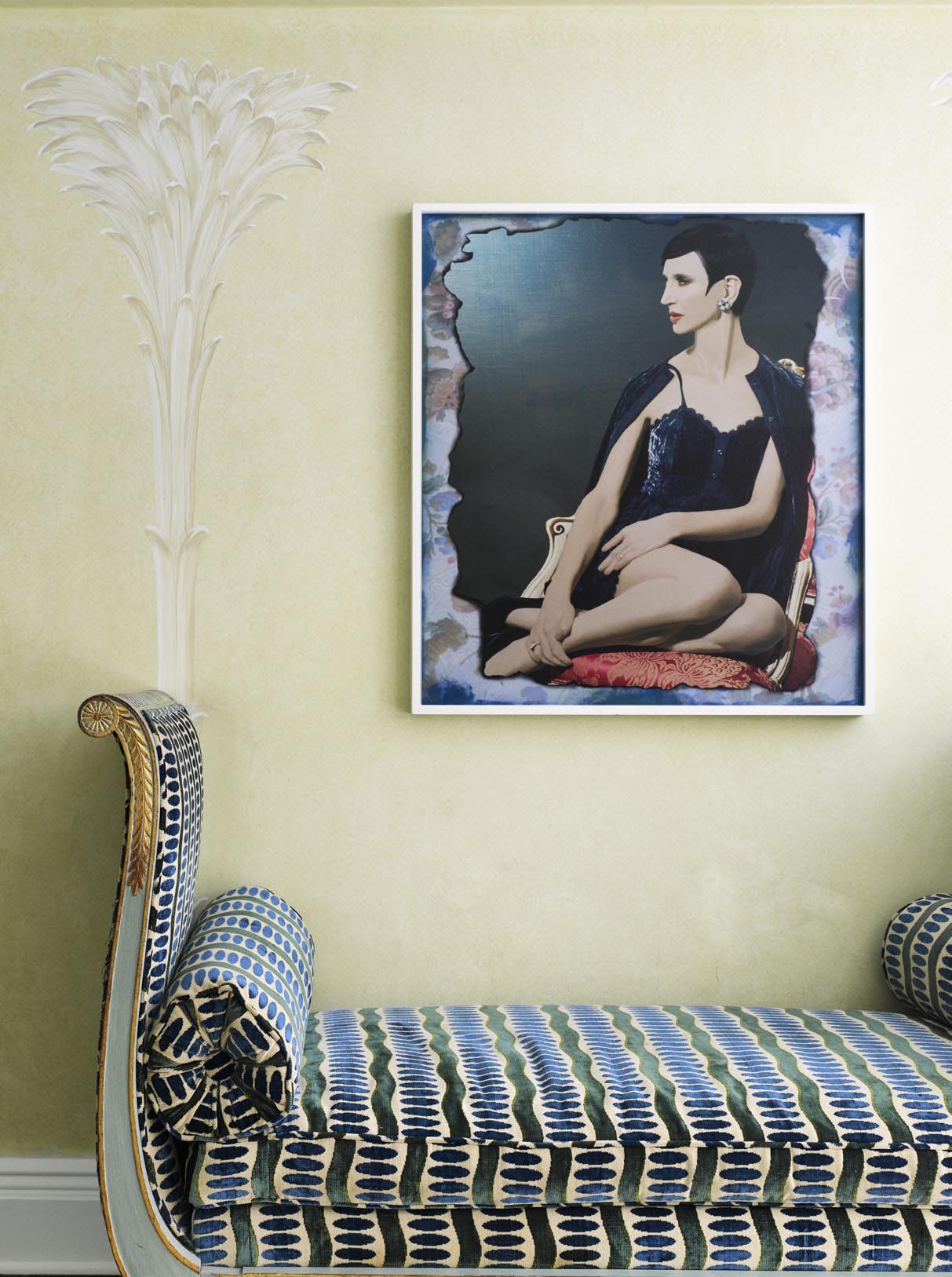
A digital portrait of Amy by Iké Udé above a Directoire-style day bed covered in Manuel Canovas cut velvet. The hallway walls are painted by Robert Hoven.
And if it is hard to put into words the visual lightning that is her living space, it’s even more of a conundrum to describe her as she moves through it like a vixen. Moves? No! Glides? No! Strides? Drifts? No! Glissades? Put them all together and you get this lanky, fascinating creature’s manner of movement. She looks as though she has been created by a team of alien artists who have been sent fashion drawings by Joe Eula or Antonio Lopez and who think that is what the human female looks like. She would never do as a template. She has said herself that she makes a self-portrait every day.
But I’m running ahead of myself, as one is wont to do in her company. The long ravishing hall stretches the length of the apartment, creating an enfilade on either side – an idea from vatic interior designer and architect Robert Couturier which changed the whole axis of the apartment. (He once said, disarmingly, “I’m completely addicted to luxury. I have no ability for anything else.”) He found the hanging lamps in Paris. The walls are painted by Robert Hoven, the Catskill-based decorator and (this is much in keeping with the high-spirited ethos of the thing) former opera singer. Indeed, he has painted almost every room in this apartment, with impeccable style and unwavering line.
Two plaster palm torchères by Serge Roche flank his console table and overmirror (while underneath hides a loony portrait of Ophelia by Vertès). Everything done by Serge Roche was chic; the son of an antique dealer, he carried on dealing, especially in old Venetian looking glasses, and then used the crafty old mirror-makers’ techniques to create his own spin, which he called the Panache style. He was fascinated by frames, by mirrors, by nature’s miracles of shape and form, especially shells, coral and rocks; and many of his lovely objects and decorative pieces – furniture, vases obelisks – are made of mirrored elements mixed with Venetian glass beads. The multi-layered glass collage chessboard by sculptor Dustin Yellin on a table in the sitting room, playing just this side of kitsch (as so much neo-baroque does), has faint if unconscious echoes of his work.
The three-dimensional palms are echoed in the ghostly trompe l’œil wall decorations – again by Hoven – and on the original parquet floor a long tufted rug called “Multiscreen,” designed by Gene Meyer and made of rectangular squares in rainbow colors, pulls the hall into an exercise in perspective.
A big portrait of Amy – a manipulated image digitally rendered by Iké Udé, a Nigerian-American journalist turned artist who works in New York and in Nollywood, the Nigerian film industry (“he sought me out to be in his magazine aRude”) – hangs over a day bed she found in a Christian Louboutin shop which was closing down. She re-covered it in an exuberant Canovas fabric. She often pounces on small old fancy boutiques with unusual fittings which are on the way out. That’s also how she came across the pair of Billy Baldwinesque gilt bamboo and glass side tables in Hélène Arpels’s shoe boutique on Park Avenue. (Even these are layered in fashion history − Hélène Arpels was part of the Van Cleef and Arpels dynasty and the Manolo Blahnik of her day.) In the hall is a pair from the set of six ravishing and gilded grotto chairs – probably Venetian –which Amy bought from a Thai dealer in New York.
In the purple-tinged dining room the Venetian sconces with their tumble of glass balls and prisms come from a Gloria Vanderbilt sale and the walls are painted by Robert Hoven with subtle pink, silver, lilac and green stripes of varying widths. One of the most remarkable pieces is a low delirious verre églomisé cabinet signed “Franky 1936.” Matelots, windswept maidens, shells and patterns in rich purples, reds and yellows frolic across its doors. Unknown artist? French? Enchanting in any case and from the Helena Rubinstein estate. The chairs are covered in scarves designed by Gene Meyer. On the dining room sideboard stands a voluptuous plaster figure of Mae West by Gladys Lewis Bush – the hour-glass torso was used in a radical design by Schiaparelli for her scent “Shocking” and came from a sale held by Schiaparelli’s granddaughter, model Marisa Berenson. The advertisements for Schiaparelli’s scents were all drawn by Marcel Vertès (everywhere you turn in this apartment you are in a lexicon of mid-twentieth-century fashion). An archway leads through to a small breakfast room hung with slinky fashion drawings including a Kenneth Paul Block drawing of three departed doyennes of fashion, Babe Paley, C.Z. Guest and Diana Vreeland, wearing the same Balenciaga evening coat.
The other end of the hall leads towards a prettily proportioned sitting room, with two fine twelve-paned windows. There’s an air of fantasy here, a layout that is fresh though laden with memories and resonance. In the middle of the room sits a triangular deep-buttoned ottoman rescued from a junk shop and restored with meticulous, not to say obsessive, care. It is covered in leopard-skin fabric, with a deep passementerie trim, and its finial is a rose quartz sphere perched on a specially cast tiny silver-plated twig.
The cascading glass Baguès sconces were found in New York, at Malmaison, the shop owned by Roger Prigent, antiquaire and dealer whose simple maxim, underlying his catholicity of taste, was that “everything is chic or not chic.”
On either side of a cabinet are rather Grant Woodish-Gothic portraits by Dorothy Gillespie of Amy’s mother, Elsa Honig Fine, and of Richard Martin, a leading art and fashion scholar. (At the time of his death in 1999 he was curator of the Costume Institute at the Metropolitan Museum of Art.) On its handle hangs a little abstract metal maquette also by Dorothy Gillespie and hanging above is a portrait of Barbara Hutton by fashion illustrator and painter Carl Erickson (Eric). Leaning out in a marked manner is a bust of the actress Linda Christian by Jacques Lipchitz. Even on the floor you are walking over a palimpsest of dense fashion and social history – Emilio Pucci, that grand fashion designer of the fifties, and René Crevel, sad surrealist poet and artist, designed the rare and sophisticated rugs.
A pair of screens, folded and tucked unobtrusively near the windows, was owned by the photographer Horst P. Horst, who adored Amy. After his death his adopted son, Ricky Horst, said, “Horst would want you to have a few things.” Amy still has the signed note written in capital letters, “HOLD THE SCREEN AND THE BOOKCASE FOR AMY FINE COLLINS. R. HORST.” The bookcase by Jean-Michel Frank, made of straw and wood, is in the main bedroom. (Billy Baldwin described Frank as “the last genius of French furniture.”) The fabric on the screens originally belonged to Coco Chanel. Horst had taken the famous photograph of Chanel reclining on a satin-covered sofa and she never looked more alluring. Amy traces the story. “Chanel developed a crush on Horst and as a thank you she sent him a lot of stuff and among it was a length of rare and valuable barkcloth. Of course he couldn’t leave well alone and stuck the cloth on to a Bauhaus screen and the glue he used has damaged the bark irreparably. The Met would like to have used them for an exhibition but they are too fragile to be moved.”
Many of Amy’s delicious things come from secret sources. Secret in two senses: where she found them, and she sometimes keeps them secret for a while before inserting them into the apartment. She regrets the plums that got away. Her Lucite chairs are by Ladislas Medgyes, a pioneering Hungarian artist who used all kinds of revolutionary new materials to design the packaging for some of Helena Rubinstein’s best-selling perfumes. “They are part of a set,” says Amy. “He designed her Lucite bed which Billy Wilder bought from her estate and I bought these chairs at Christie’s years later.” Her voice is maybe a little bit sad when she speaks of the bed. “I didn’t buy it because I was worried about overspending and then where would I place it?” The subtext is that of many wives whose husbands are not collectors. (I know the subtext too well.)
“I cyclically get uncontrollable urges to bid at an auction – and win. I’m a bit of a bottom fisher,” she says, of the way she often finds forgotten things at the end of a sale, like the pretty flower painting in her sitting room which she found at Christie’s. It was by “a couturier who had stopped being a couturier.” Molyneux. “No one else seemed to know who he was. I shop in shops and in flea markets, especially the Paris flea markets. Without which my apartment would not be adequately furnished.”
The word adequate is not one that fits here. Dazzling is better. A nineteenth-century aesthete and art critic (and perhaps multiple murderer), one Thomas Griffiths Wainewright, who had a passionate love for stuff (stuff in the Shakespearean sense – “We are such stuff as dreams are made on”), once wrote: “Things that spring up under my nose dazzle me. I must look at them through Time’s Telescope.” That’s it here.